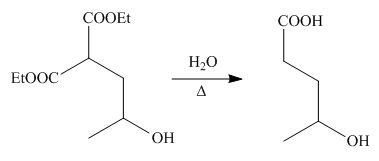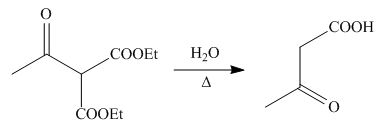
Concept explainers
(a)
Interpretation: The products formed by the reaction of
Concept introduction: Nucleophilic addition reaction is a type of organic reaction in which the nucleophile is added to the electrophilic site. The carbon atom in carbonyl compound acts as an electrophilic centre where a nucleophile attacks and gives an addition product.
Answer to Problem 23.47P
The product formed by the reaction of
Explanation of Solution
The given compound is,

Figure 1
The nucleophile

Figure 2
On the further treatment of

Figure 3
Hence, the product formed by the reaction of
The product formed by the reaction of
(b)
Interpretation: The products formed by the reaction of
Concept introduction: Nucleophilic addition reaction is a type of organic reaction in which the nucleophile is added to the electrophilic site. The carbon atom in carbonyl compound acts as an electrophilic centre where a nucleophile attacks and gives an addition product.
Answer to Problem 23.47P
The product formed by the reaction of
Explanation of Solution
The given compound is,

Figure 4
The nucleophile

Figure 5
On the further treatment of

Figure 6
Hence, the product formed by the reaction of
The product formed by the reaction of
(c)
Interpretation: The products formed by the reaction of
Concept introduction: Nucleophilic addition reaction is a type of organic reaction in which the nucleophile is added to the electrophilic site. The carbon atom in carbonyl compound acts as an electrophilic centre where a nucleophile attacks and gives an addition product.
Answer to Problem 23.47P
The product formed by the reaction of
Explanation of Solution
The given compound is,

Figure 7
The nucleophile

Figure 8
On the further treatment of

Figure 9
Hence, the product formed by the reaction of
The product formed by the reaction of
(d)
Interpretation: The product formed by the reaction of
Concept introduction: Nucleophilic addition reaction is a type of organic reaction in which the nucleophile is added to the electrophilic site. The carbon atom in carbonyl compound acts as an electrophilic centre where a nucleophile attacks and gives an addition product.
Answer to Problem 23.47P
The products formed by the reaction of
Explanation of Solution
The given compound is,

Figure 10
The nucleophile

Figure 11
On the further treatment of

Figure 12
Hence, the products formed by the reaction of
The products formed by the reaction of
Want to see more full solutions like this?
Chapter 23 Solutions
Package: Loose Leaf for Organic Chemistry with Biological Topics with Connect Access Card
- curved arrows are used to illustrate the flow of electrons. using the provided starting and product structures, draw the cured electron-pushing arrows for thw following reaction or mechanistic steps. be sure to account for all bond-breaking and bond making stepsarrow_forwardUsing the graphs could you help me explain the answers. I assumed that both graphs are proportional to the inverse of time, I think. Could you please help me.arrow_forwardSynthesis of Dibenzalacetone [References] Draw structures for the carbonyl electrophile and enolate nucleophile that react to give the enone below. Question 1 1 pt Question 2 1 pt Question 3 1 pt H Question 4 1 pt Question 5 1 pt Question 6 1 pt Question 7 1pt Question 8 1 pt Progress: 7/8 items Que Feb 24 at You do not have to consider stereochemistry. . Draw the enolate ion in its carbanion form. • Draw one structure per sketcher. Add additional sketchers using the drop-down menu in the bottom right corner. ⚫ Separate multiple reactants using the + sign from the drop-down menu. ? 4arrow_forward
- Shown below is the mechanism presented for the formation of biasplatin in reference 1 from the Background and Experiment document. The amounts used of each reactant are shown. Either draw or describe a better alternative to this mechanism. (Note that the first step represents two steps combined and the proton loss is not even shown; fixing these is not the desired improvement.) (Hints: The first step is correct, the second step is not; and the amount of the anhydride is in large excess to serve a purpose.)arrow_forwardHi I need help on the question provided in the image.arrow_forwardDraw a reasonable mechanism for the following reaction:arrow_forward
- Draw the mechanism for the following reaction: CH3 CH3 Et-OH Et Edit the reaction by drawing all steps in the appropriate boxes and connecting them with reaction arrows. Add charges where needed. Electron-flow arrows should start on the electron(s) of an atom or a bond and should end on an atom, bond, or location where a new bond should be created. H± EXP. L CONT. י Α [1] осн CH3 а CH3 :Ö Et H 0 N о S 0 Br Et-ÖH | P LL Farrow_forward20.00 mL of 0.150 M NaOH is titrated with 37.75 mL of HCl. What is the molarity of the HCl?arrow_forward20.00 mL of 0.025 M HCl is titrated with 0.035 M KOH. What volume of KOH is needed?arrow_forward
- 20.00 mL of 0.150 M NaOH is titrated with 37.75 mL of HCl. What is the molarity of the HCl?arrow_forward20.00 mL of 0.025 M HCl is titrated with 0.035 M KOH. What volume of KOH is needed?arrow_forward20.00 mL of 0.150 M HCl is titrated with 37.75 mL of NaOH. What is the molarity of the NaOH?arrow_forward

 Organic ChemistryChemistryISBN:9781305580350Author:William H. Brown, Brent L. Iverson, Eric Anslyn, Christopher S. FootePublisher:Cengage Learning
Organic ChemistryChemistryISBN:9781305580350Author:William H. Brown, Brent L. Iverson, Eric Anslyn, Christopher S. FootePublisher:Cengage Learning

